Perennials for Pots
May 24th, 2007
Pat King of Swatara Twp. was getting frustrated trying to find the perfect plants for a pair of large, dark-bronze pots on her front porch.
Nothing in the whole annual-flower section matched.
“Especially for shade or morning sun, there just wasn’t much variety,” she says. “So I started looking in the houseplant, herb and perennials areas.”
It wasn’t long before she hit pay dirt – a trailing golden-leafed perennial called creeping jenny (Lysimachia nummularia ‘Aurea’).
“The contrast of the gold against the dark bronze, along with the nicely spaced leaves, is very attractive,” King says. “And this Lysimachia usually survives the winter just left in the pot. I have plenty the following year.”
Other gardeners are beginning to discover what King did – that pots aren’t just for annual flowers. There’s no reason why perennials can’t be mixed with annuals or even used to fill a pot themselves.
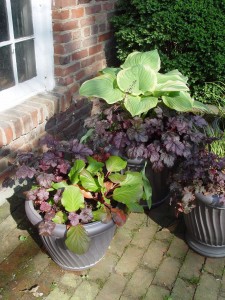
These pots are filled with nothing but perennials: hosta, coralbells and bergenia.
The bonus is that unlike annuals, which get tossed at season’s end (unless you’re adept at taking cuttings), perennials are recyclable. They’re cold-hardy enough to survive winter for reuse the following season.
“Last year was the first year we had a lot of people asking if they could use perennials in pots,” says Kathy Quarles, manager at Country Market Nursery in Upper Allen Twp. “The foliage color is what’s attracting them.”
In the past, the big strike against perennials was their limited bloom times. While it’s not unusual for an annual flower to bloom non-stop from Mother’s Day through fall frost, most perennials bloom only for four to six weeks.
But breeders lately have been coming up not only with perennial varieties that bloom longer, they’ve focused heavily on ones with attractive, colorful and/or variegated leaves. That color sticks around all season and often beyond frost.
“I think it was Proven Winners’ Fall Magic line that first got people thinking,” says Quarles.
That line, which debuted in the late 1990s, focused on hardy plants that had foliage that looked good in fall, including purple-leaf sage, golden sedge grass and several ajugas with bronze and pink variegated leaves. More than a few of them ended up in pots.
The cold-hardiness of most perennials also lets people get an early start on their pots in spring and gives the option of changing out the plants around them as the season progresses, says Melanie Trea, greenhouse manager at Stauffer’s of Kissel Hill in Linglestown.
“Perennials are usually a little larger to start with, so you get that ‘wow’ right away,” she says.
Example: A gardener could start out in early spring with a perennial euphorbia or coralbells in a pot, surrounded by cold-hardy pansies or spring bulbs. Come hot weather, summer annuals could replace the pansies and bulbs. Then in fall, mums or ornamental kale could replace the annuals.
“This really gives you more shapes and sizes and textures to pick from,” says Trea.
King says these days when she’s plant-hunting, she doesn’t pay attention to the categories.
“What I look for is a color or a form to go in a pot,” she says. “I don’t limit the search to the type of plant.”
That’s led her to such stunning combinations as a dark-leafed ‘Burnished Bronze’ foamybells (a perennial) with two New Guinea impatiens (annuals), three golden creepy jennies (perennials) and an asparagus fern (a popular houseplant).
Summer care is similar to the standard care for annuals in pots. Perennials in pots will need more water than perennials planted in the ground, but their bigger root systems make them a bit less thirsty than annuals.
Perennials that grow beyond where you want them can be snipped back to keep any from overpowering the display.
At season’s end, you’ve got a few choices.
“I just leave my perennials right in the pots,” says Quarles. “When they start to die back for the season, I just move the pots up against the garage.”
King overwinters most of her pots in a patio protected from winter winds on two sides by house walls. They’re out in the open enough, though, that they catch rain and snow.
“As long as the soil is frozen, I don’t water them,” she says. “As spring arrives, I water if it’s a dry spell and the temperatures are above 40.”
King also points out that her pots are all double-walled plastic or fiberglass. Those give the perennial roots a bit of extra insulation and are crack-resistant.
Trea says another option is to move the pots into an unheated spot inside.
“A garage is fine,” she says. “Just leave the perennials right in the pots. If you have a place in the yard, you could also bury them, pots and all.”
Trea says the main threat of leaving perennials in above-ground pots out in the open is not so much the cold but the vulnerability to repeated freezing and thawing.
“In the ground, perennials are more likely to freeze and stay frozen,” she says. “In a pot, they’ll freeze and thaw. That’s what really hurts them.”
Another option is that come mid to late October, you can remove perennials from the pots and plant them in the ground. Look either for a permanent home where they look good in the landscape or simply plant them in a holding bed for reuse in next spring’s pots.
Another bonus of perennials is that most of them grow enough in one or two seasons that you’ll be able to split them into additional plants.
And yet another plus is that you may be able to find good perennial pot candidates already growing in your yard. Take a look around and see if you’ve got anything that can be dug up, divided and transplanted into a pot or two with some matching annuals.
The possibilities are endless.
Or as King puts it, “So many things to try, so few pots!”
A few colorful pot-candidate perennials:
Acorus ‘Ogon’
Ajuga ‘Bronze Beauty’
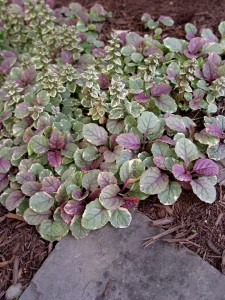
Ajuga 'Burgundy Glow'
Ajuga ‘Burgundy Glow’
Ajuga ‘Chocolate Chip’
Artemisia
Barrenwort
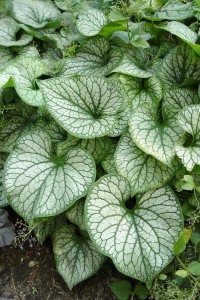
Brunnera 'Jack Frost'
Brunnera ‘Jack Frost’
Brunnera ‘Looking Glass’
Cimicifuga ‘Brunette’ or ‘Black Negligee’
Coralbells ‘Amber Wave’
Coralbells ‘Caramel’
Coralbells ‘Green Spice’
Coralbells ‘Gypsy Dancer’
Coralbells ‘Hollywood’
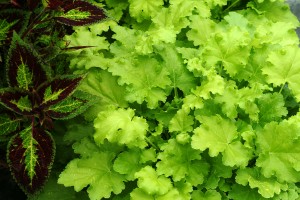
Coralbells 'Lime Rickey'
Coralbells ‘Lime Rickey’
Coralbells ‘Peach Flambe’
Coreopsis ‘Heaven’s Gate’
Dwarf fountain grass
Euphorbia ‘Chameleon’
Euphorbia ‘Helen’s Blush’
Foamflowers ‘Black Snowflake’
Foamflowers ‘Jeepers Creepers’

Foamflower 'Sugar and Spice'
Foamflowers ‘Sugar and Spice’
Foamybells ‘Burnished Bronze’
Foamybells ‘Stoplight’
Fringe-leafed bleeding heart
Golden creeping jenny
Golden oregano
Golden sedge grass (Carex)
Golden or gold-variegated Japanese forest grass
Hardy geranium ‘Ann Folkard’
Hardy geranium ‘Rozanne’
Hosta
Japanese bloodgrass
Japanese painted fern
Lady’s mantle
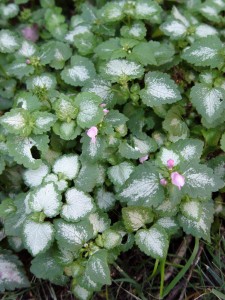
Lamium 'Pink Chablis'
Lamium ‘Pink Chablis’ or ‘Shell Pink’
Lamium ‘White Nancy’
Ligularia ‘Britt-Marie Crawford’
Liriope ‘Okina’
Lungwort (Pulmonaria)
Mukdenia ‘Crimson Fans’
Persicaria ‘Chocolate Dragon’
Pineapple sage
Purple sage
Red switchgrass ‘Shenandoah’
Silver thyme
Tricolor sage
Variegated Jacob’s ladder ‘Snow and Sapphires’
Variegated Jacob’s ladder ‘Stairway to Heaven’
Variegated iris
Variegated liriope
Variegated phlox ‘Nora Leigh’







